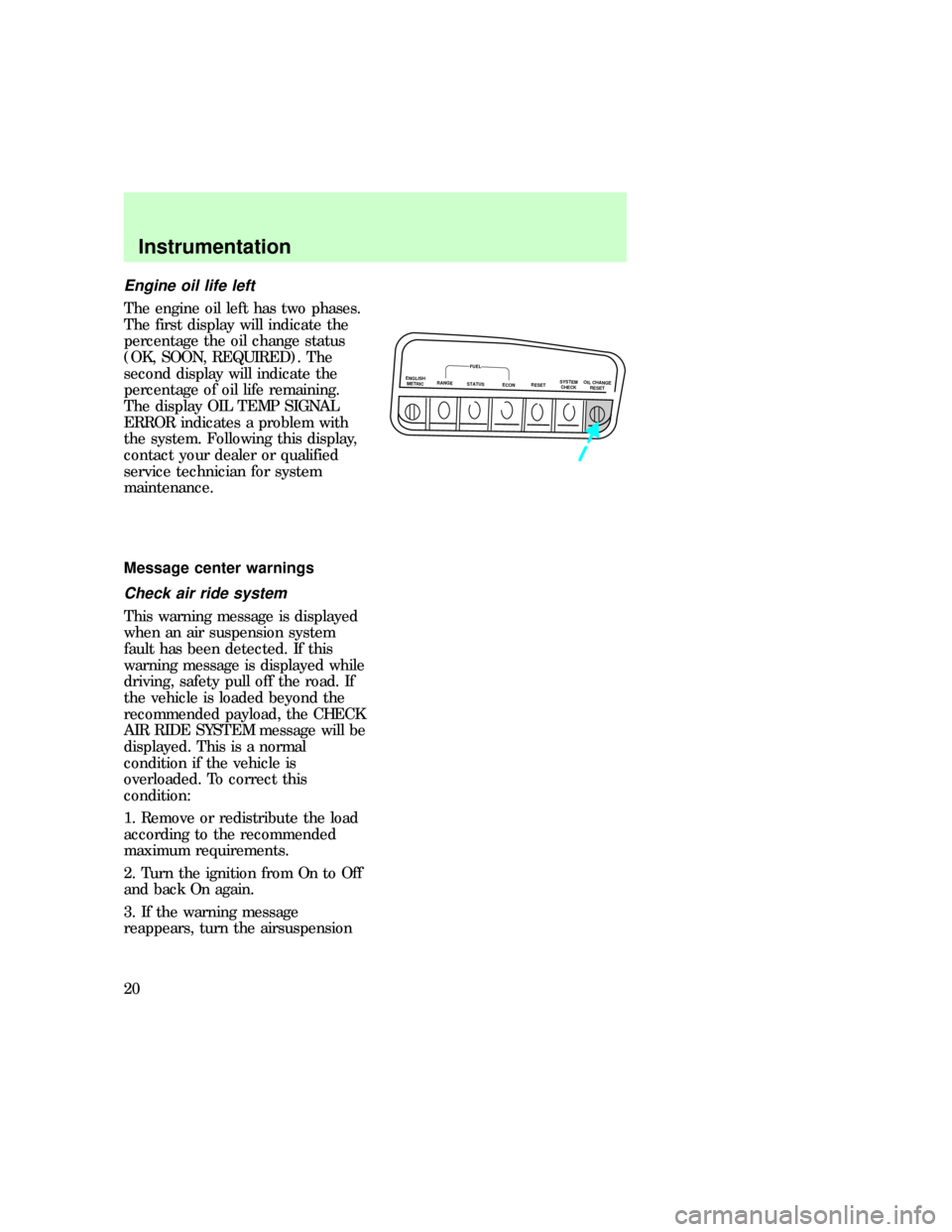Page 19 of 236

Engine oil life left
The engine oil left has two phases.
The first display will indicate the
percentage the oil change status
(OK, SOON, REQUIRED). The
second display will indicate the
percentage of oil life remaining.
The display OIL TEMP SIGNAL
ERROR indicates a problem with
the system. Following this display,
contact your dealer or qualified
service technician for system
maintenance.
Message center warnings
Check air ride system
This warning message is displayed
when an air suspension system
fault has been detected. If this
warning message is displayed while
driving, safety pull off the road. If
the vehicle is loaded beyond the
recommended payload, the CHECK
AIR RIDE SYSTEM message will be
displayed. This is a normal
condition if the vehicle is
overloaded. To correct this
condition:
1. Remove or redistribute the load
according to the recommended
maximum requirements.
2. Turn the ignition from On to Off
and back On again.
3. If the warning message
reappears, turn the airsuspension
ENGLISH
METRICRANGESTATUS
ECONRESETSYSTEM
CHECKOIL CHANGE
RESET
FUEL
uno_warnings_title
uno_check_air_ride
Instrumentation
20
Page 20 of 236
switch Off and have your vehicle
serviced as soon as possible.
Air ride switch off
The air ride suspension switch is
off. Refer toAir suspension
systemin theControls and
featureschapter for more
information.
Change oil soon
The engine oil life remaining is 5%
or less. After you have the oil
changed, you must reset the M/C
Oil Life Left feature as follows:
1. Turn the ignition to the On or
Acc position.
2. Press and hold the OIL
CHANGE RESET control for five
seconds. After a successful reset,
the message center will display
ªOIL LIFE RESET TO 100%.º
You may also set a Personalized Oil
Reset Procedure using the
following:
1. Turn the ignition to the ON or
ACC position.
2. Press and hold the OIL
CHANGE RESET control and press
the RESET control while the
display is counting down the five
seconds to reset. The display will
ENGLISH
METRICRANGESTATUS
ECONRESETSYSTEM
CHECKOIL CHANGE
RESET
FUEL
uno_air_ride
uno_change_oil
Instrumentation
21
Page 37 of 236
Wipers
For rear wiper operation, rotate
the rear window wiper and washer
control to the desired interval
position.
Automatic ride control
(if equipped)
Your vehicle is equipped with an
automatic ride control system. This
system is designed to level your
vehicle when towing or carrying a
heavy load.
To prevent sudden vehicle
movement, turn off the air
suspension switch prior to jacking,
towing or hoisting the vehicle.
4WD CONTROL (IF EQUIPPED)
This control operates the Control
Trac 4WD. Refer toControl trac
systemin theDrivingchapter for
more information.
020
1030405060
70
80
90
110
120000000ooookm/h10020406080100
120
140
160
1800P RND21UNLEADED
FUEL ONLY
RPM x 100012345
6H
C
FERSM
SET
ACC
COAST OFF ONOFF
SRSHI LOOFF*A/C*MAX
A/C
REW
1FF
2SIDE 1-2
3
FM 1STVOL – PUSH ON
AM
FMBASS TREBBAL FADE
AUTO
SET CLKSEEKTUNE
DISCSSCAN4DOLBY SYSTEMEJTAPE CDCOMP5SHUFFLE
6
PUSH
OFFHIR. WIPE
PUSH
uno_4wd_switch
uno_fuel_pump_shut_off_ref
Controls and features
38
Page 119 of 236

based on driver and road inputs to
optimize ride. The combination of
firm dampening and height change
also provides maximum suspension
feedback for improved off-road
safety and performance.
The vehicle will drop to its lowest
position when the ignition is
turned to the Off position to
provide easy entry and exit to of
the vehicle. As a safety
consideration, whenever a door is
opened (including the liftgate and
liftgate glass), the system
memorizes and maintains the
height at the moment the door was
opened. The system will maintain
this height either until all doors
are closed or until vehicle speed
exceeds 16 kph (10 mph).
An on board air compressor and
solenoids are used to raise and
lower the vehicle. It is normal to
occasionally a buzz or clicking
from the vehicle even when the
ignition is turned to Off. The
system stays energized for 40
minutes after the ignition is turned
off to compensate for any load
changes after the vehicle is parked.
The Automatic Ride Control
system operation can be monitored
through the message center. Refer
toMessage centerin the
Instrumentationchapter.
uno_ride_cont_switch
Driving
120
Page 137 of 236

TRAILER TOWING
Trailer towing with your vehicle
may require the use of a trailer
tow option package.
Trailer towing puts additional loads
on your vehicle's engine,
transmission, axle, brakes, tires,
and suspension. For your safety
and to maximize vehicle
performance, be sure to use the
proper equipment while towing.
Follow these guidelines to ensure
safe towing procedure:
²Stay within your vehicle's load
limits.
²Thoroughly prepare your vehicle
for towing. Refer toPreparing
to towin this chapter.
²Use extra caution when driving
while trailer towing. Refer to
Driving while towingin this
chapter.
²Service your vehicle more
frequently if you tow a trailer.
Refer to the severe duty
schedule in the ªService Guideº.
²Do not tow a trailer until your
vehicle has been driven at least
800 km (500 miles).
²Refer to the instructions
included with towing accessories
for the proper installation and
adjustment specifications.
²Speed control may shut off if
you are towing on long, steep
grades.
Driving
138
Page 153 of 236
Maxi fuses
Fuse Amperage Circuits protected
1 30 Rear window defrost
2 30 PCM power relay
3 20 Fuel system, anti-theft
system
4 20 Headlamps
5 30 ABS system
6 30 ABS system
7 20 Trailer park LP and
trailer stop LP
8 30 Battery saver relay
and headlamp relay
9 50 Blower motor
10 30 Power locks, power
windows and power
seats
11 20 PCM memory and
horn
12 50 Air ride control relay
13 60 Instrument panel fuse
panel
14 60 Ignition
Mini fuses
1 30 JBL system
2 15 Rear wiper system
3 30 Power point
4 20 4WD system
5 15 Air suspension system
6 15 Alternator system
7 10 Air bag system
8 15 DRL/Fog
lamps/Off-road lamps
9 - Not used
Roadside emergencies
154
Page 157 of 236
8. Assemble the jack handle to the
lug wrench.
9. Insert the drive section of the
jack handle into the actuator hole
and turn counterclockwise until
the cable is slack enough to allow
the spare tire to be pulled
rearward from under the vehicle.
10. Slide spare tire rearward and
remove retainer.
11. Insert tapered end of the lug
wrench behind hubcaps and twist
them off.
12. Loosen the wheel lug nuts with
the lug wrench about one half turn
each.
13. Position the jack on the lower
suspension arm to raise the front
wheel. Position the jack under the
rear axle to raise the rear wheel.
²Never use the differential as
a jacking point.
14. Turn the jack handle clockwise
until the tire just clears the
ground.
15. Remove the wheel lug nuts and
flat tire and install the spare tire.
Roadside emergencies
158
Page 201 of 236
them. If this does not work,
remove the chains to prevent
vehicle damage.
²Avoid overloading your vehicle.
²Remove the tire chains when
they are no longer needed. Do
not use chains on dry roads.
²The suspension insulation and
bumpers will help prevent
vehicle damage. Do not remove
these components from the
vehicle when using snow tires
and chains.
If equipped with 110 cm (17 inch)
tires, your vehicle will not
accommodate snow chains. Consult
your dealer for information on
other Ford approved methods of
traction control.
IMPORTANT FUEL
INFORMATION
Important safety precautions
Do not overfill the fuel
tank. The pressure in an
overfilled tank may cause
leakage and lead to fuel spray
and fire.
If you do not use the
proper fuel cap, the
pressure in the fuel tank can
damage the fuel system or cause
it to work improperly in a
collision.
uno_fuel_info_title
com_important_precautions.06
Maintenance and care
202